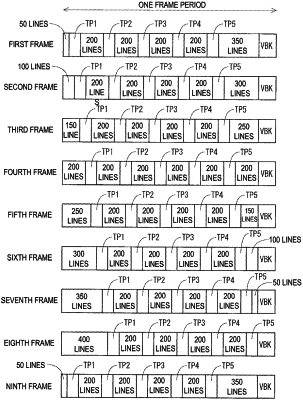| CPC G06F 3/0412 (2013.01) [G06F 3/04166 (2019.05); G09G 3/3648 (2013.01); G09G 2310/0213 (2013.01); G09G 2310/0286 (2013.01); G09G 2310/08 (2013.01); G09G 2320/02 (2013.01)] | 6 Claims |

|
1. A driving method for a liquid crystal display device including a plurality of video signal lines configured to transmit a video signal, a plurality of scanning signal lines intersecting the plurality of video signal lines, a liquid crystal panel including a display portion including pixel forming sections provided in a matrix shape in a plurality of rows and a plurality of columns in correspondence to the plurality of video signal lines and the plurality of scanning signal lines, and a sensor electrode for touch position detection built into the liquid crystal panel, the driving method comprising:
scanning the plurality of scanning signal lines, one by one, to write the video signal, via a corresponding video signal line of the plurality of video signal lines, into each of the pixel forming sections provided in the plurality of rows and the plurality of columns; and
driving the sensor electrode for the touch position detection after the scanning of a scanning signal line of the plurality of scanning signal lines is stopped,
wherein a stop row, being a row where the scanning of the scanning signal line is stopped in the driving of the sensor electrode, is different in a first frame period and a second frame period, the first and second frame periods being two consecutive frame periods,
in the first frame period, all of the plurality of scanning signal lines are scanned one by one, and
in the second frame period, all of the plurality of scanning signal lines are scanned one by one.
|